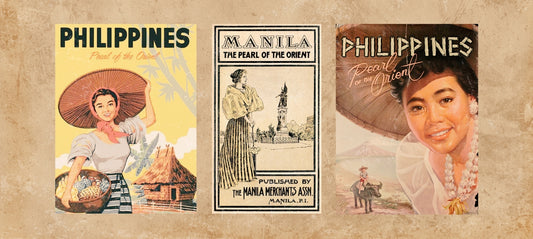The Philippines is both a hotspot and a mega-diversity area, making it a priority for conservation. The country’s forests are habitat for more than 6,000 plant species and numerous bird and animal species, many are critically endangered like the Paphiopedilum fowliei orchid and the Visayan tarictic hornbill.
Exceptionally lush and full of life, Filipino Tropico is a series of embroidery designs conceptualized and illustrated by Chesleigh Nofiel (previously Alaga At Sining), VINTA's in-house surface designer and artist. Filipino Tropico features the wonder and beauty of Philippine flora and fauna in meticulous detail.
F i l i p i n o T r o p i c o I

Filipino Tropico I includes the Visayan Hornbill, Anahaw, Red Ginger, Red Torch, and is featured on our Mens Classic Barong and our New Chinoy Barong
Visayan Hornbill (Penelopides panini)
The Visayan hornbill is a highly endangered species of hornbill found in rainforests on the islands of Panay, Negros, Masbate, and Guimaras, and formerly Ticao, in the Philippines. The total is estimated at 1,800 individuals. There has been a heavy decline in population due to hunting and loss of habitat caused by deforestation.
Anahaw (Saribus rotundifolius)
Saribus rotundifolius, the round-leaf fountain palm, is a palm found in Southeast Asia. It is also called footstool palm and as anahaw or luyong. The foliage of the Saribus rotundifolius is the official national leaf of the Philippines.
Red Ginger (Alpinia purpurata)
The red ginger is an evergreen, herbaceous, perennial plant producing a clump of leafy stems. Also called ostrich plume and pink cone ginger, with showy flowers on long brightly colored red bracts. They look like the bloom, but the true flower is the small white flower on top.The plant is harvested from the wild for local use as a medicine. Widely grown as an ornamental in the tropics, the flower is often used in the cut flower industry.
Red Torch (Etlingera elatior)
Also known Philippine wax flower, is a fast-growing species of herbaceous perennial plant that has been actively introduced as an ornamental throughout the tropics; it is also widely cultivated in tropical countries and used as spice for food flavouring.
F i l i p i n o T r o p i c o I I
 Filipino Tropico II includes the Tamsi, Traveller’s Palm, Venus Slipper, and Kapa-kapa, and is featured on our Unisex Striped Linen Weekender Barong.
Filipino Tropico II includes the Tamsi, Traveller’s Palm, Venus Slipper, and Kapa-kapa, and is featured on our Unisex Striped Linen Weekender Barong.
Tamsi (Cinnyris jugularis)
The yellow-bellied sunbird, is a southern Far Eastern species of sunbird that is commonly known as "tamsi" in the Philippines. The sunbirds are a group of very small Old World passerine birds which feed largely on nectar, although they will also take insects, especially when feeding young. Their flight is fast and direct on their short wings. Most species can take nectar by hovering, but usually perch to feed most of the time.
Traveller’s Palm (Ravenala madagascariensis)
Ravenala is a genus of flowering plants with a single species, Ravenala madagascariensis, commonly known as traveller's tree or traveller's palm, from Madagascar. Displaying big, fan-like leaves, the name is actually a bit of a misnomer, as traveller’s palm is not a true palm, but actually more closely related to banana trees. This exotic plant produces small, creamy white flowers, which often appear year round.
Venus Slipper (Paphiopedilum fowliei)
Paphiopedilum fowliei is a species of plant in the family Orchidaceae, endemic to the southeast side of Palawan in the Philippines. Its natural habitat is subtropical or tropical moist lowland forests and is threatened by habitat loss.
Kapa-kapa (Medinilla magnifica)
Locally known as Kapa-kapa, the showy medinilla or rose grape is a species of flowering plant in the family Melastomataceae, native to the Philippines. This evergreen plant is also commonly known as the Philippine orchid, and it is an epiphyte.
F i l i p i n o T r o p i c o I I I

Filipino Tropico III includes the Tamsi, Birds of Paradise, Galamai, and Taro, and is featured on our Crop Barong Blouse.
Birds of Paradise (Heliconia rostata)
The Heliconia also known as hanging lobster's claw is a popular ornamental plant in the Philippines. It's an herbaceous perennial that produces waves of pendant flowers. Birds of Paradise is native to Peru, Bolivia, Colombia, Costa Rica, and Ecuador. It has naturalized in the Philippines, presumably from being brought through the Spanish Galleon trade. Other Heliconias grow in the upright position, their cup-shaped flower bracts store water for birds and insects.
Galamai (Schefflera elliptifoliola)
Scheffleras are shrubs or trees, sometimes climbers or epiphytes, usually with palmately compound leaves. Five to six species of Shefflera elliptifoliola are endemic to the Philippines, and can be found in primary forests at low and medium altitudes in Rizal, Laguna, Quezon, and Camarines provinces in Luzon; and in Catanduanes, Mindoro, and Mindanao.
Taro (Alocasia boyceana)
The Alocasia boyceana can only be found in the Philippines. It is sometimes known as "biga" or "taro", it is also known as Kris Pant, Elephant Ear, or African mask becuase of their very large, glossy heart-shaped leaves with wavy edges. Tropical plants in the Alocasia genus feature stunning foliage that can become the centerpiece of a garden or room.
Tamsi (Cinnyris jugularis)
The yellow-bellied sunbird, is a southern Far Eastern species of sunbird that is commonly known as "tamsi" in the Philippines. The sunbirds are a group of very small Old World passerine birds which feed largely on nectar, although they will also take insects, especially when feeding young. Their flight is fast and direct on their short wings. Most species can take nectar by hovering, but usually perch to feed most of the time.
F i l i p i n o T r o p i c o I V

Filipino Tropico IV includes the Kalaw, Kibatalia puberula, Paphiopedilum ciliolare, Phalaenopsis lindenii, Aerides leeana, Vanda javierae* and is featured on our Relaxed Classic Pechera Barong and our Ruffle Barong.
*All species listed above are threatened flora and avifauna that can only be found in the Philippines.
Kibatalia puberula
Kibatalia is an endangered species of evergreen plant with white flowers in the family Apocynaceae that can only be found in Samar, Philippines.
Kalaw (Buceros hydrocorax)
This is the most majestic and biggest of all Philippine Hornbills - the Great Rufous Hornbill, locally known as “Kalaw” is endemic to the Philippines, specifically in Luzon and Marinduque. According to the IUCN Red List of Threatened Species, this species is considered as vulnerable. Hornbills are the best, cheapest and the most natural way to re-grow our forests: They are "Farmers of the Forests" as hornbills distribute the seeds of the fruits they fed on.
Paphiopedilum ciliolare
Paphiopedilum ciliolare is an endangered species of flowering plant in the orchid family, Orchidaceae. It is known commonly as the short haired paphiopedilum. It is endemic to the Philippines. This is a rare orchid with a total wild population of fewer than 2,500 mature individual plants.
Phalaenopsis lindenii
Phalaenopsis lindenii is an endangered species of plant in the family Orchidaceae, named after Belgian botanist Jean Jules Linden. It is endemic to the island of Luzon in the Philippines. Its natural habitat is subtropical or tropical moist lowland forests. It is threatened by habitat loss.
Aerides leeana
Aerides leeana is a vulnerable species of plant in the family Orchidaceae that is threatened by habitat loss. It is endemic to the Philippines and its natural habitat is subtropical or tropical moist lowland forests. It occurs on Luzon in severely fragmented habitats (Bataan, Camarines Norte, Camarines Sur, Cavite, Quezon, Rizal) and Samar Islands.
Vanda javierae
Vanda javierae is one of the most outstanding of all Vanda species. The fact that it is mainly white in colour almost makes it unique. Vanda javierae is an endangered species of flowering plant in the orchid family, Orchidaceae. This species grows in island forest habitat. It is endemic to the Philippines, where it occurs on Luzon and Calayan Island. It is known commonly as Mrs. Javier's vanda.








